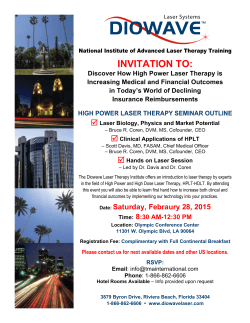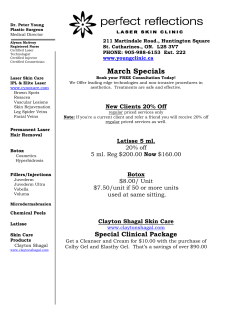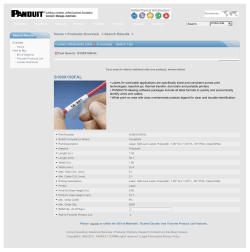
Laser Physics Homework 5, Due Date
Laser Physics: PHYS 5734/4734 Spring 2015, Homework Set - 5 Due: Friday, Noon April 10, 2015 Submit only * problems R1=0.985 1. In the ring laser cavity shown in the figure, the lens has focal length f = 75.0 cm and the wavelength of light is λ = 633 nm. (a) What is the waist spot radius wo ? Round trip length L=1.50 m R3=0.97 R2=0.97 (b) What is the axial and transverse mode separation? Scattering loss 1% per pass (c) What is the photon life time and cavity Q? 2.* Homogeneous and inhomogeneous absorption (chemical lasers): THz By burning D2 and F2 to get chemically excited DF molecules, and then letting them expand through a supersonic nozzle we can make very powerful lasers that can generate hundreds of kW cw (continuous wave) power. Such lasers have been proposed as military weapons (if the laser doesn’t get them the toxic chemicals will!). The peak absorption coefficient versus pressure of the λ = 3.67 µm transition of the DF molecule at room temperature is linear at low pressures and essentially flat at high pressures (see Fig. 3.21 in Siegman). Explain this behavior. Hint: At low pressures the line is Doppler broadened Gaussian and at high pressure it is pressure broadened Lorentzian. Natural broadening is negligible in both cases. 3.* Absorption coeffiecient (a) Absorption in Na-vapor: Estimate the absorption coefficient for 589 nm transition in sodium vapor containing 2.70 × 1012 atoms/cm3 at 200o C. For decay rates, lifetimes etc., see Table 3.1 on pp 122 in Siegman and note that the radiative life time should be 16 ns. Hint: It is easily shown, using the ideal gas law, that the number of atoms per cm3 of an ideal gas at pressure P (in torr) and temperature T (in degrees K) is given by N (atoms/cm3 ) = 9.65 × 1018 P (torr) . T (o K) You are encouraged but not required (so no credit for deriving) this result. (b) Absorption coefficient of ruby: The gain medium for the first laser, demonstrated in 1960, was a ruby rod pumped by a flash lamp. (Ruby is a crystal of Al2 O3 into which a small amount of Cr3+ has been doped). The absorption in the red (at 694.3 nm) is due to resonant transitions in the Cr ions. A typical concentration of Cr3+ ions is 2 × 1019 cm−3 . The radiative lifetime is 3 ms, and the linewidth is ∆νH = 11 cm−1 . [cm−1 as a unit of frequency is used in certain branches of physics and chemistry. In this unit, frequency is defined as 1/λ, where λ is the vacuum wavelength expressed in cm. To convert frequencies in units of wavenumber into Hz, we simply multiply it by the speed of light in free space.] Take the refractive index of ruby to be 1.7. 1 (i) Calculate the absorption coefficient in an un-pumped ruby crystal. (ii) What fraction of the intensity of a beam of 694.3-nm-wavelength light is transmitted through a 1-cm thick ruby crystal of this type? 4.* How many modes? Consider an atomic transition at 500 nm with a width of ∆λ = 0.10 nm, in a cavity of volume 2.0 cm3 and (refractive index ) n = 1. (a) Convert the wavelength interval 0.10 nm into linewidth ∆ν in frequency units and find the number of electromagnetic modes of this cavity in this frequency band. (b) Assuming that the cavity is in the form of a circular cylinder of cross-section 0.10 cm2 and thus 20.0 cm long. How many HG00p modes will fit under the frequency band specified by the 0.10 nm interval? Remember that each mode can have two polarizations. (c) What is the probability that the atom will emit into one of these modes? 5.* Maximum output power from a laser is proportional to saturation intensity. Estimate saturation intensity for the following lasers (a) He:Ne laser with λ = 632.8 nm, peak emission cross-section σo = 5.8 × 10−13 cm2 , upper state life time 30 ns. (b) Ar-ion laser laser with λ = 514.5 nm, peak emission cross-section σo = 2.5 × 10−13 cm2 , upper state life time 6 ns. (c) Nd-YAG laser with λ = 1.064 µm, peak emission cross-section σo = 2.8 × 10−19 cm2 , upper state life time 230 µs. (d) Rhodamine 6G dye laser with λ = 570 nm, peak emission cross-section σo = 3.2 × 10−16 cm2 , upper state life time 5.5 ns. 6.* (Bonus for PHYS 4734) Consider a laser transition between levels shown in the figure to the right. The pump excites the atoms to level E2 at a rate R2 . Level E2 decays to state E2=5.5 eV E1 at a rate γ21 = 107 Hz and to state E0 at a 6 rate γ20 = 5 × 10 Hz. Level E1 decays so fast γ21 that the approximation N1 ≈ 0 is valid. The radiative decay rate for E2 → E1 transition is E1=3.2 eV R 6 × 106 Hz and its width is 10 GHz. Assume 2 a homogeneously broadened Lorentzian line γ20 profile and steady-state. (a) Calculate the stimulated emission crosssection and saturation intensity for the E2 → E1 transition? (b) What must be the pump rate R2 to achieve a small signal gain coefficient of 1.0 % cm−1 ? (c) How much power is expended in creating the gain coefficient of (b)? 2 E0
© Copyright 2025











